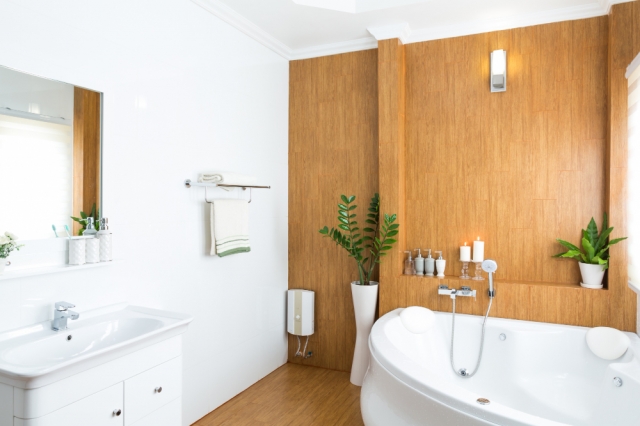When it comes to bathroom renovations, it's important to choose materials that can withstand the unique demands of this high-moisture environment. The right materials will ensure your bathroom remains functional, durable, and visually appealing for years to come, even with regular use and exposure to water, steam, and humidity.
Flooring: Durable Options for High-Traffic Areas
Bathroom floors must be able to handle frequent water exposure, foot traffic, and potential spills. Some of the best options for bathroom renovation projects include:
- Natural Stone Tiles: Granite, marble, and travertine offer a luxurious, high-end look for bathroom floors during renovations. However, these materials require regular sealing to maintain their appearance and prevent water damage. They can also be more slippery when wet, so it's important to choose a honed or textured finish for added traction. Consulting with a local bathroom renovation contractor can help ensure the proper selection and installation.
- Ceramic and Porcelain Tiles: These are classic, water-resistant options that are highly durable and available in a wide range of styles, colours, and textures. Porcelain tiles are especially well-suited for high-traffic bathrooms, as they are more dense and less porous than standard ceramic tiles, making them more resistant to stains and wear.
- Vinyl and Luxury Vinyl Tile (LVT): More affordable than natural stone, these water-resistant options are also durable and can mimic the look of more expensive materials, such as wood or stone. LVT is particularly popular due to its ease of installation and resistance to scratches, dents, and moisture.
Walls: Moisture-Resistant Surfaces for Long-Lasting Protection
Bathroom walls must be able to withstand splashing, moisture, and humidity. Suitable options include:
- Tile: Ceramic or porcelain tiles provide a waterproof surface, as long as the grout is properly sealed to prevent water infiltration. Larger format tiles can also help minimize grout lines, which can be a common area for moisture buildup.
- Moisture-Resistant Drywall: Also known as “green board”, this drywall is designed to resist moisture and humidity, making it a practical choice for bathroom walls during renovations. It's a more affordable alternative to tile, but it doesn't offer the same level of water resistance.
- Solid Surfaces: Materials like cultured marble or engineered quartz offer a seamless, easy-to-clean look and are highly resistant to water damage. These surfaces are particularly well-suited for bathroom walls, as they eliminate the need for grout and can create a cohesive, modern aesthetic.
Fixtures and Fittings: Invest in Quality for the Long Term
Bathroom fixtures and fittings should be both stylish and durable to withstand daily use, even after a bathroom renovation. Consider the following options:
- Faucets and Showerheads: Choose brass or stainless steel fixtures, as these materials are known for their longevity and resistance to corrosion. Avoid cheaper, plated finishes that may wear down over time.
- Toilets: Opt for a toilet with a siphonic flushing system, which ensures reliable and efficient performance for years to come. Look for models with a glazed, easy-to-clean bowl and an ADA-compliant height for added comfort.
- Vanities and Cabinetry: Solid wood or engineered wood are better choices than MDF or particle board, which can swell and degrade when exposed to moisture. Consider using a water-resistant finish or sealant to further protect the cabinetry.
Countertops: Durable and Attractive Surfaces for Daily Use
The bathroom countertop needs to withstand daily use, spills, and potential water exposure. Some good options include:
- Quartz: A low-maintenance, durable, and highly customizable option that is resistant to scratches, stains, and heat. Quartz is also non-porous, making it an excellent choice for bathrooms.
- Granite: Provides a high-end, natural stone look, but requires occasional resealing to maintain its appearance and water-resistance. Granite is a more porous material, so it's important to seal it properly.
- Solid Surface and Laminate: More affordable options that are also durable and easy to clean, making them a practical choice for bathrooms. Solid surface materials, such as Corian, are especially well-suited for bathrooms due to their seamless design and resistance to water damage.
Lighting and Ventilation: Essential Elements for a Comfortable, Functional Space
Proper lighting and ventilation are crucial for creating a comfortable, functional bathroom environment:
- Recessed LED Lighting: Efficient, long-lasting, and able to withstand moisture, recessed LED fixtures are an excellent choice for bathroom lighting. They can provide ambient, task, and accent lighting to create a well-lit and visually appealing space.
- Vanity Lighting: Waterproof fixtures installed above the vanity mirror are important for providing well-lit grooming and makeup areas. Look for fixtures with a rating of at least IPX4 to ensure they can handle the bathroom's moisture levels.
- Exhaust Fans: Look for high CFM (cubic feet per minute) ratings to ensure the fan effectively removes moisture and odours from the bathroom. Properly sized and installed exhaust fans can help prevent mould and mildew growth.
Summary
When renovating a bathroom, it's crucial to select durable, moisture-resistant materials that can withstand the unique challenges of this high-use, high-moisture environment. By prioritizing quality over cost, you can create a bathroom that not only looks beautiful, but also remains functional and long-lasting, even after the renovation is complete. From flooring and wall surfaces to fixtures, fittings, and ventilation, each element plays a vital role in the longevity of your bathroom. Investing in proven, high-performance materials will pay dividends in the long run, ensuring your bathroom renovation project results in a space that continues to serve you and your family for years to come.






